Drop Shot Setup For Bass (Catch More Bass With A Drop Shot Rig)
The drop shot rig is versatile and can be used in freshwater and saltwater applications.
You can catch all kinds of gamefish with this simple rig.
Especially bass.
There are days when we’ll spend hours without a single bite.
It’s part of the game. It happens.
If you know anything about bass, they’ll just about hit anything you throw at them when they’re in the mood. Which makes it even more frustrating.
If you’re local lakes and ponds are crowded like ours, pressured bass living in these waters are timid and getting really smart.
So when you’re fishing in these conditions, you’ll need to step your game up.
This is where a drop shot setup for bass comes into play. The drop shot rig is usually our go-to setup when nothing is working.
In this guide, you’ll learn everything you need to know on how to properly use a drop shot rig for bass, including:
- The right weights to use
- The proper knots
- The best hooks to use
- The best plastic baits for this rig to catch bass
- The best hook-to-sinker leader length
Once you learn the basics, you can experiment with different baits and leader lengths.
It’s one of our favorite rigs when fishing for bass. It’s easy to set up, effective and works when nothing else does.
We recently headed to a local pond in our area and used nothing but the setup described in this guide. Keep reading to see all the bass we were able to land!
Let’s begin
What’s A Drop Shot Rig? The Setup Tackle
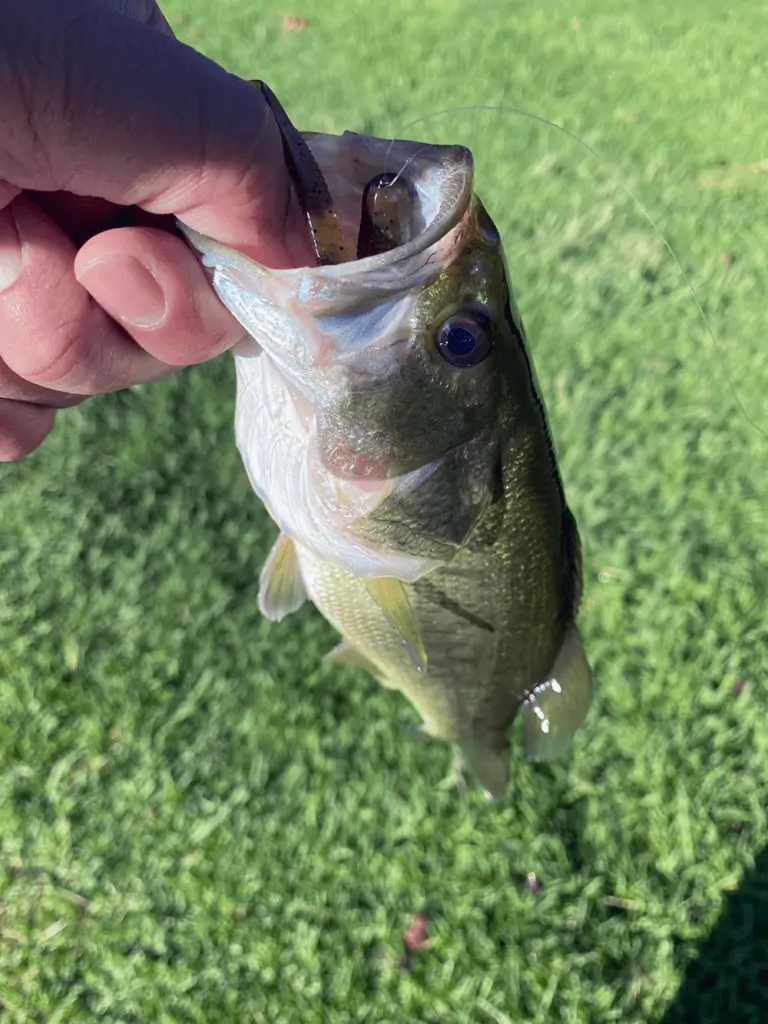
A drop shot rig is when you tie a hook directly to your line (using a Palomar knot), leaving enough tag line (trailing leader) where the weight is tied to the end. The length of the trailing leader (distance between the weight and the hook) can be anywhere from 12″ to 18″.
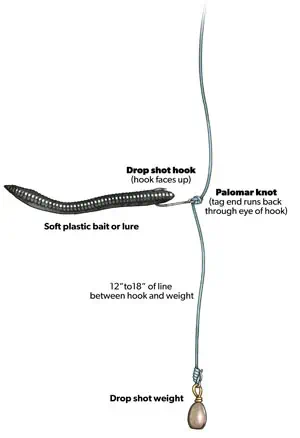
Why Does This Rig Work So Well?
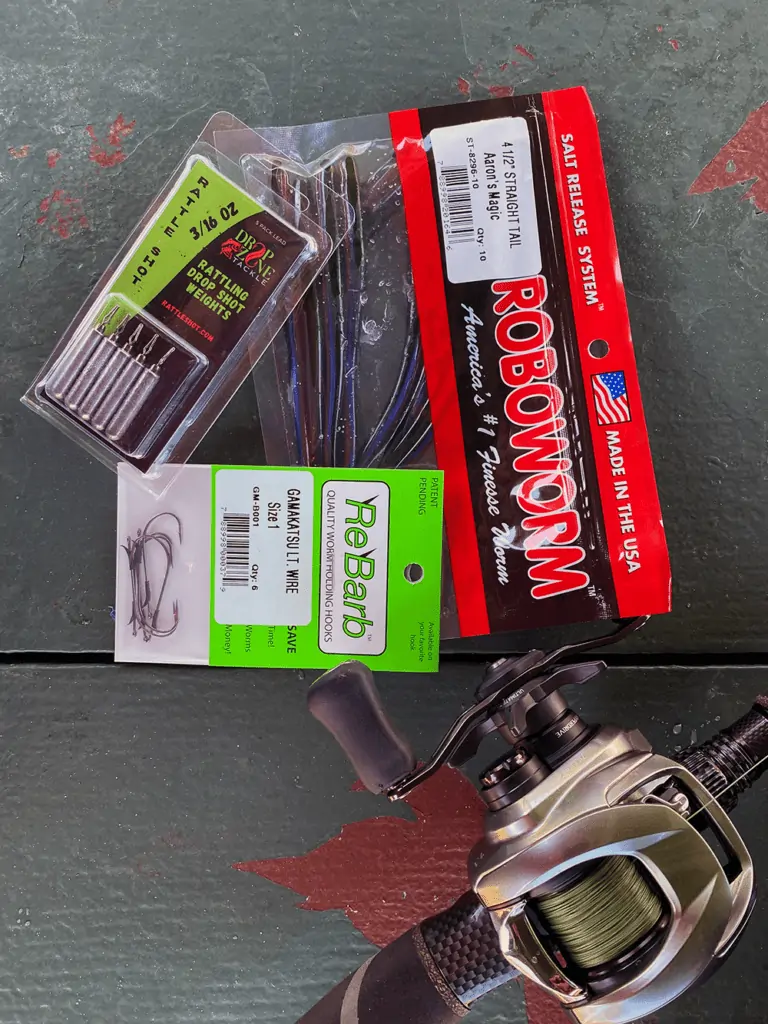
There are many reasons why we believe dropshotting for bass and other gamefish, such as:
- It provides a more natural presentation for finesse soft plastic baits that bass can’t resist
- Adjusting where the hook is tied allows you to keep your bait in the strike zone (in front of the bass) longer
- Can quickly take your bait down for deep water bass
- It is versatile in that it can be fished around rocks, weeds, or submerged logs
Presentation
Regarding finesse fishing (small soft plastic lures on semi-light fishing gear), nothing comes close to having your bait move realistically with a couple of light twitches of your rod tip.
And because we’re using smaller soft plastic baits, bass will see this as a low-risk opportunity for a quick meal.
And because we’re the bait is suspended right in their face, it’s only a matter of time for the bass to hit. You should also make sure you choose the right type of line when fishing for bass as well.
We often see anglers out on the water incorrectly retrieving their finesse worm when dropshotting. Instead, they would cast it out and start cranking it back in before the weight even gets a chance to hit bottom.
Keep reading below for the best techniques when using the drop shot for bass.
Hook Size And Location Tips
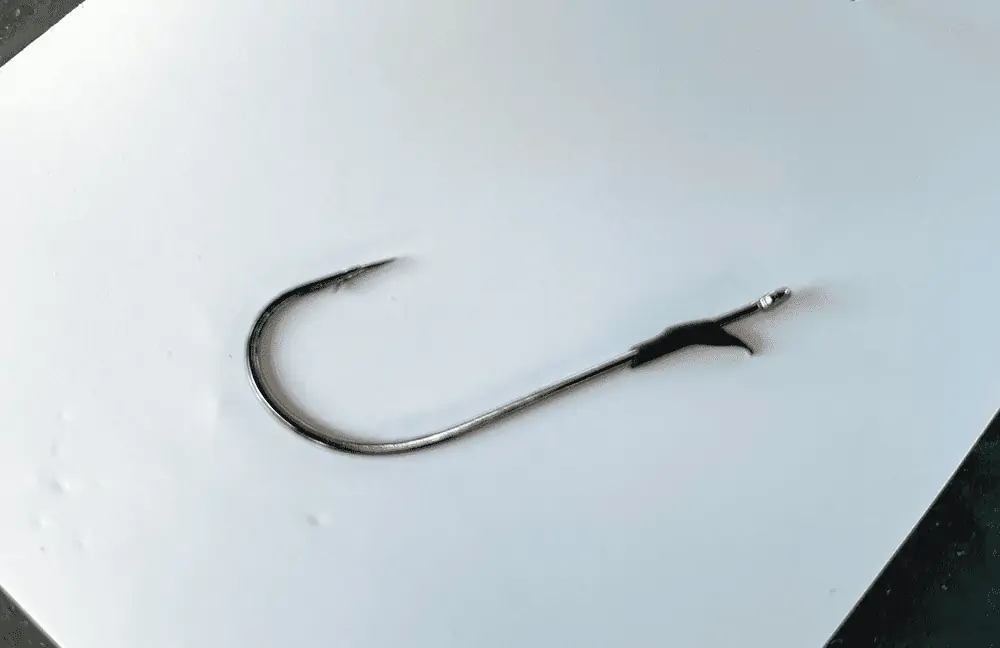
One of the most common mistakes anglers make when using a drop shot rig is using a heavy wire gauge or too large of a hook. The best hook size is typically a size 1 or 2 straight shank worm hook.
Make sure it’s a light wire hook because this will give your finesse baits a more life-like appearance.
Tying Your Hook To Your Main Line
The most common knot to tie your hook to your line is the Palomar knot, but an important extra step at the end (mentioned below) will increase your chances of catching bass with this rig.
Rigging Your Soft Plastics
There are a few ways to hook your baits for bass fishing:
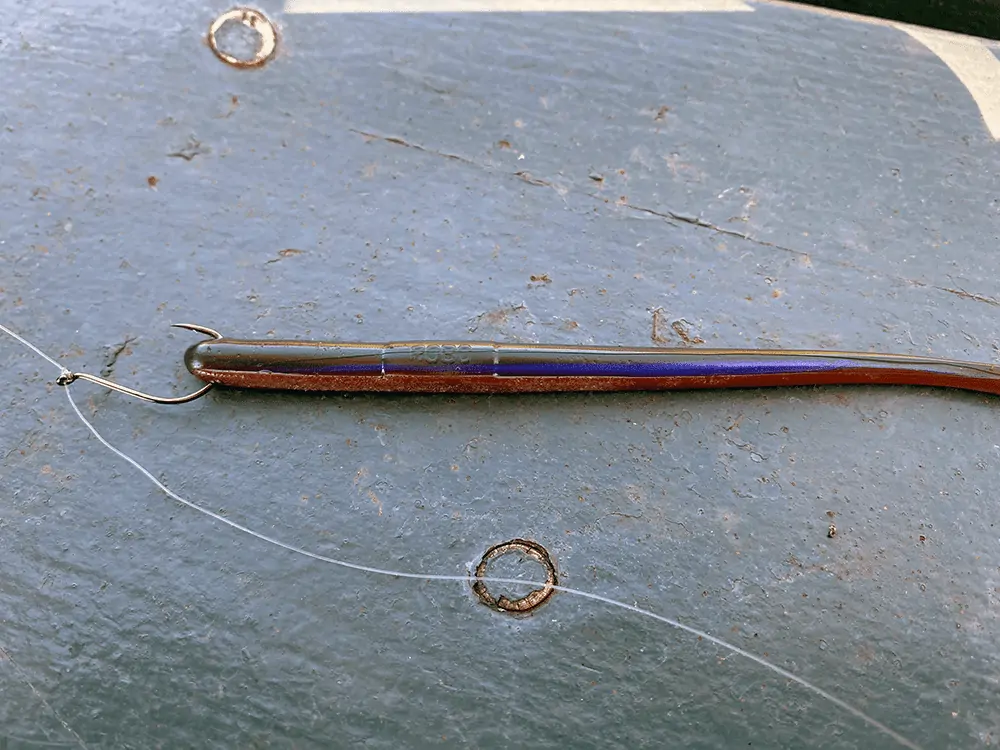
Nose hook rigging – Insert your hook from underneath about 1/4″ from the front and pierce all the way through.
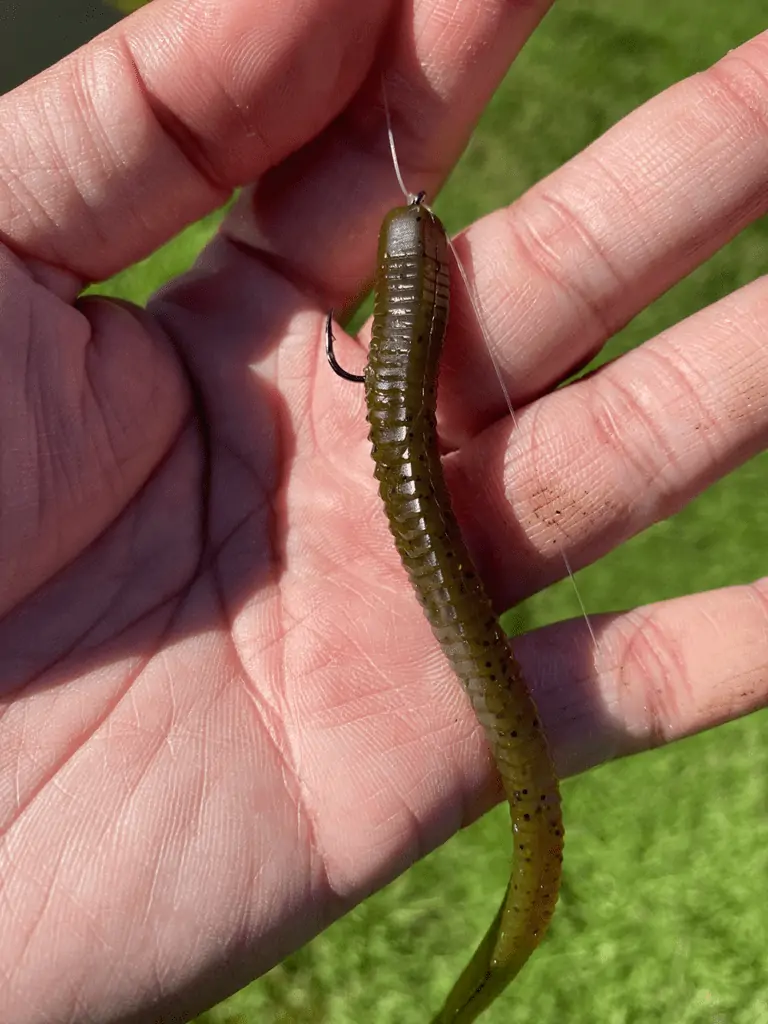
Hidden nose hook rigging (Threaded) – Insert the hook from the front end of the bait and thread through enough to have the bait hide the straight part of the shank
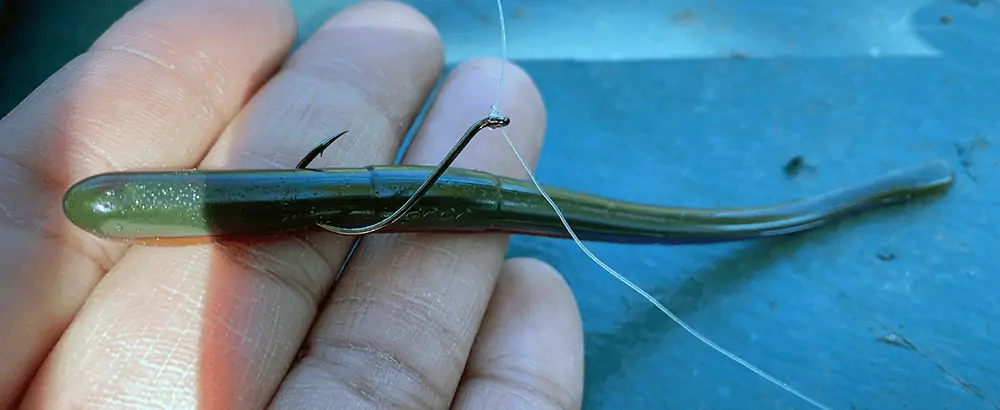
Gilly rigging – This is when you hook the plastic worm through the side about 3/4 to an inch away from the tip
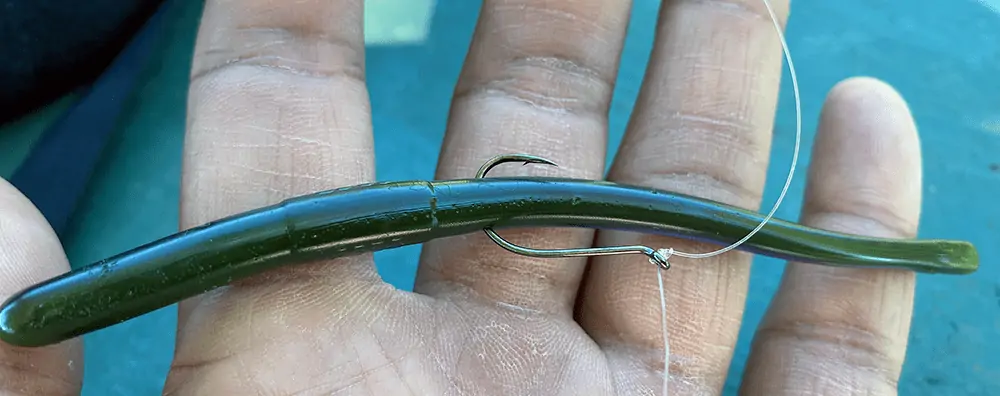
Wacky rigging – When you hook the soft plastic on the side around the middle.
Nose rigging allows the bait to swim more freely, in our opinion. However, if you’re fishing pressured bass in your over-crowded community pond…
Consider rigging your soft plastic bait via the hidden nose (threaded) method.
As for the Gilly and Wacky, this style is great when bass are nibbling your baits instead of inhaling them. It also provides more vibration on the retrieve.
Our favorite methods for hooking are the hidden nose hook and wacky. We’ve tried nose-hooking our worms in the past, and we do get a lot of bites, but we feel that we also lose a lot of fish this way for some reason.
We like using 4.5″ straight tail Robo worms along with a unique re-barb hook designed to hold the worm more securely when rigging via the hidden nose method.
Another way to hook your bait is the weedless Texas rig. We don’t really like this way of hooking because it restricts the movement of your finesse baits. But if you’re fishing in thick floating mats and thick grass, have at it.
Step 1: Make sure your hook point is pointing up before you start.
Step 2: Make a Palomar knot with the desired tag line length you wish to have. That leader length is the distance your bait will be above the weight.
Tip: If the eye of your hook is too small to pass through the double line formed by the loop needed for the Palomar knot, simply insert your fishing line once through the eye and take the end and insert it back into the eye of the hook to form your loop.
Step 3: Once you’ve completed your Palomar knot, there’s one extra step, as mentioned above, that you’ll need to do to have your hook stand perpendicular to your line.
Take the end of your tag end line and insert it back in the eye of the hook from the top, then pull it straight down.
What Drop Shot Weight To Use
You want to be able to use the lightest weight possible for this rig setup. How light?
Heavy enough to hit bottom but light enough so that you can barely feel the weight when lifting your rod tip up. Here are the common weight sizes based on the depth of water you’re fishing in:
- If you’re fishing in water 15 feet or less, use 3/16 or 1/4 oz weights
- If you’re fishing deeper than 15 feet of water, use 3/8 or 1/2 oz weights
If your weight is too heavy, it restricts the movement of your bait, and as you’re retrieving, the bait will just get dragged near the bottom.
Conversely, using too light of a weight, you risk not getting your bait in front of the bass. You also won’t be able to cast too far as well.
Weight Shape
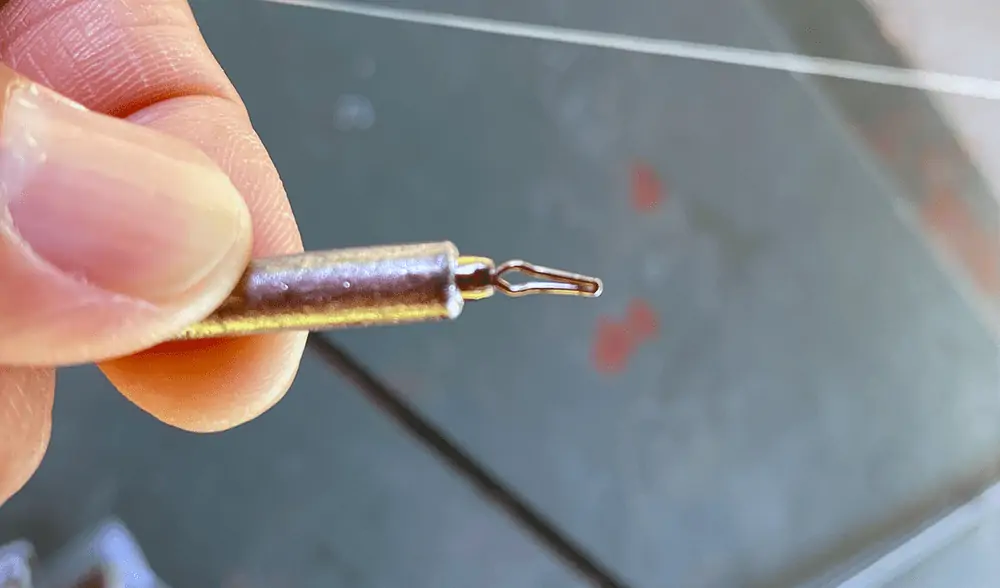
Drop shot weights will have a swivel or a quick-release clasp. The shape of the weight is also important, depending on a few factors:
- Rocky bottom: Use a round or teardrop weight so it won’t get snagged in cracks because of its wider shape.
- Weeds: Use a cylinder weight to freely move in and out of weeds because of its streamlined shape.
Tying Your Drop Shot Weight
The old-school drop shot weights will have part of a swivel sticking at the top. Tie whatever knot you choose at the end of your tag line.
Newer weights have a pinch-type clasp where you gently tug your line enough for the weight to grip on. They work great, and if you get snagged, you’ll just end up losing just your weight instead of the entire rig.
How To Fish A Drop Shot Rig
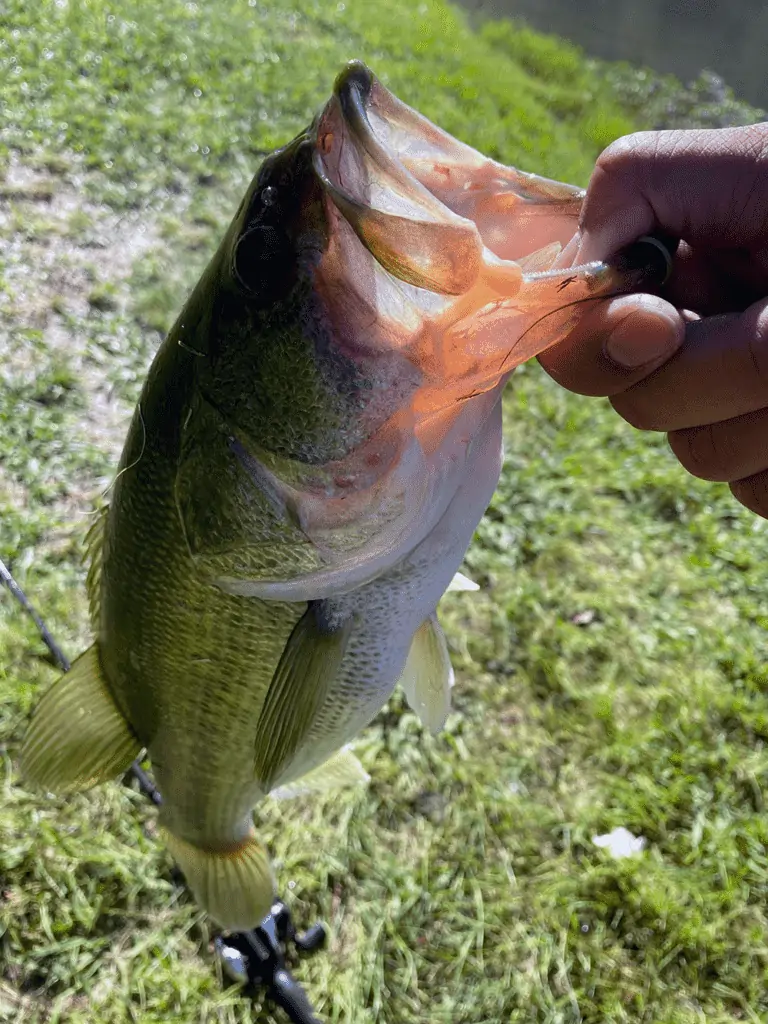
Now that you’ve properly set up a drop shot rig for bass fishing, we’ll show you how to fish this rig effectively.
The beauty of this rig for bass or any other gamefish is that the technique is easy to learn. Here are 5 killer techniques to catch bass using this rig (in no particular order):
- Jigging: Cast out and let your weight hit bottom. Slowly jig your bait back, moving your rod tip, reel in the slack, and repeat. You want to envision counting how many rocks your weight is hitting on the bottom floor.
- Slow Drag: Cast out and let your weight hit bottom. Slowly drag your bait back. If your weight hits a rock or any other laydowns, quickly jig it out and continue the drag.
- Deadsticking: This technique requires a little patience. You’re casting out your bait and letting it sit there for a while. This is a great way to catch pressured bass. Make sure to keep an eye on your slack. Bass will typically hit your bait on the fall. Or they’ll wait a couple of seconds before they hit it off the bottom.
- Drifting in Current: Let the current in the river you’re fishing do the work here. Cast out and let your bait start drifting, all while being suspended and covering a wider area. We recommend going a little heavier on the weights, such as a 1/2 oz.
- Jerking: Cast your bait out and let it hit bottom. Quickly jerk your rod once, then pause. Next, do two short, quick jerks and pause again. Reel in your slack and repeat the process. This technique works well because it mimics a shad in distress and looking for cover. We’ve caught a ton of bass this way.
Rod and Reel For Dropshotting
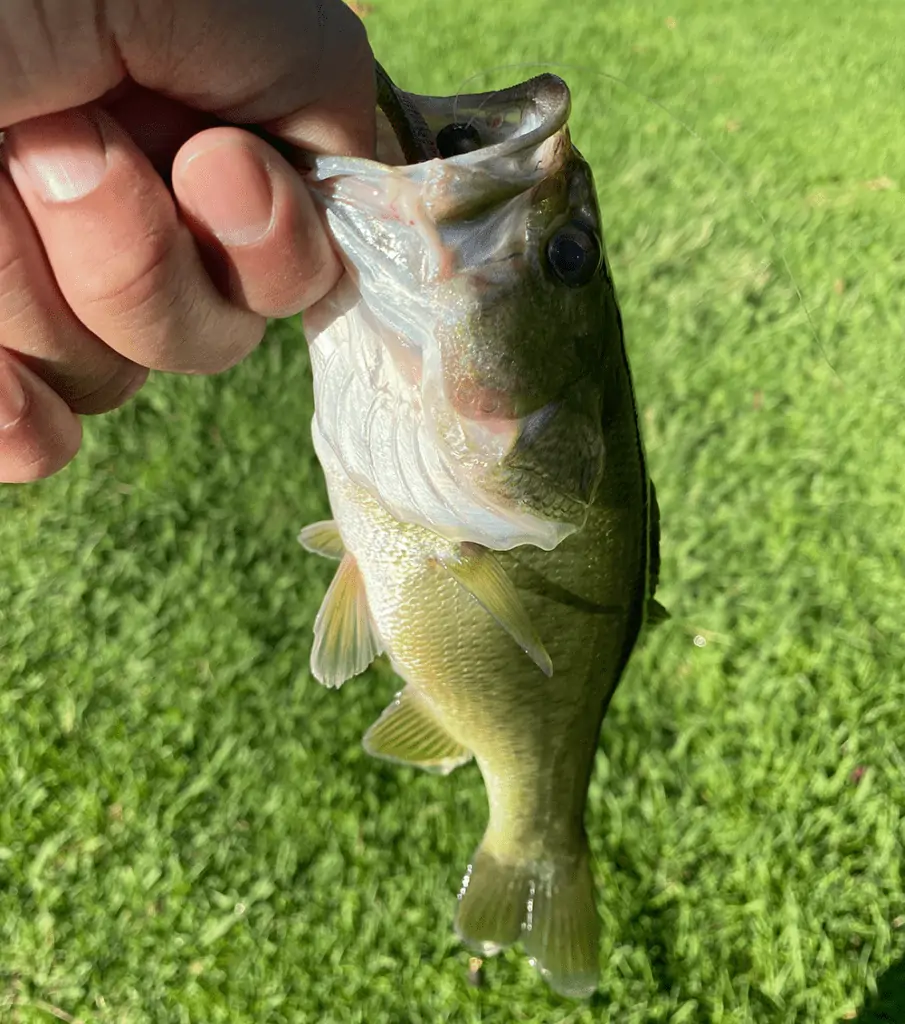
You can use any rod or reel you like, as long as it provides enough sensitivity to feel the light bites.
Many anglers successfully catch bass with either an ultra-light rod setup or a casting rod.
As for the reel, you want to use one that has a smooth drag. This is key because when a bass hits, they typically head straight for cover. If your drag is set too tight, you risk breaking your line. If it’s too loose, then you might as well not even be fishing because the fish will just strip all your line out.
A great all-around rod for drop shotting is a 7-foot medium action spinning rod paired with a spinning reel spooled with an 8 – 14-pound test fluorocarbon or mono line.
You can use a baitcaster as well. Just make sure the reel has a good drag. That’s all we use here, but an ultralight spinning reel combo will allow you to cast out further and feel the light bites better.
Lead vs. Tungsten Weights
We’re not going to go into the debate about why one is better than the other. We’re going to say that tungsten weights are smaller, harder, and more expensive. But they do provide a better feel because of their small size. They also sink faster than lead because of their density.
The choice is ultimately up to you, but if you can afford it, go with tungsten. We actually have used both, so it’s all preference.
The Best Baits To Use On A Drop Shot Rig
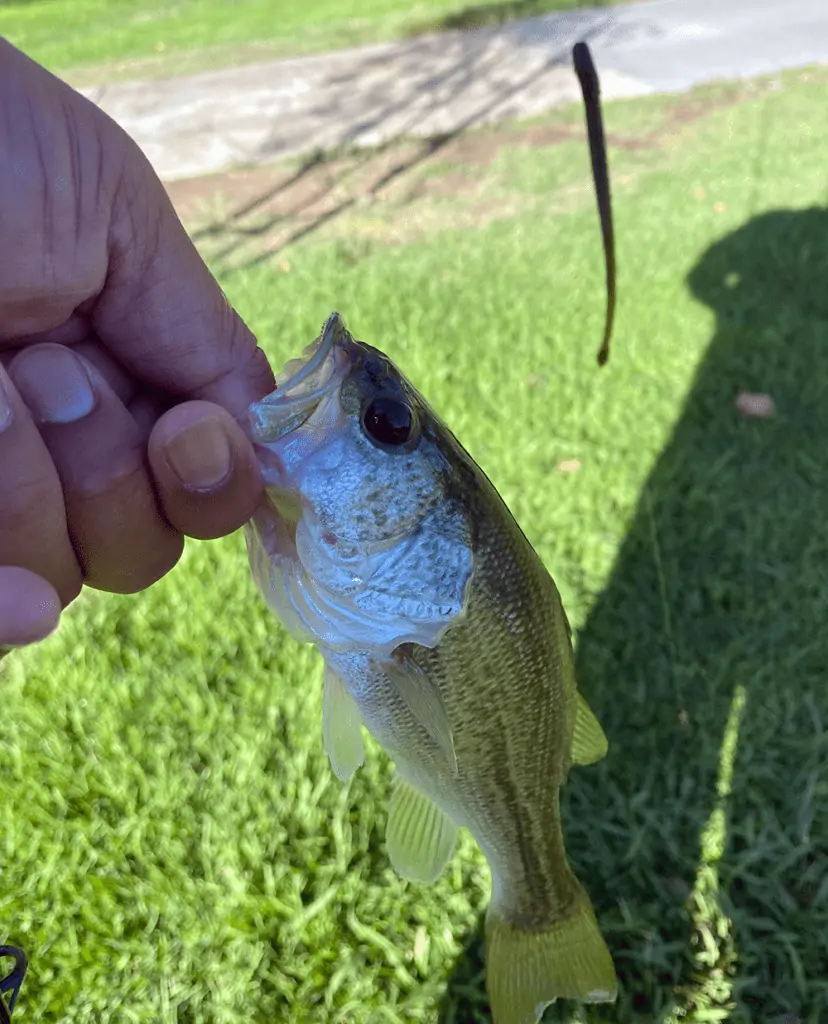
This is where it gets fun because you can use just about any type of bait on this rig. For example, we’ve successfully used small plastic worms, grubs, shad bodies, and minnows in the 4.5″ to 5″ lengths.
But really, you can use just about anything small enough to fit on the hook. The key is to experiment and see what works best in your area.
As for worm colors, we’ve had the most success using:
- watermelon red
- green pumpkin
- black/blue
But again, it all comes down to preference and what the bass are hitting that day.
Final Thoughts
Drop shotting for bass is an extremely versatile and effective technique that every angler should have in their arsenal. You’ll catch bass all day long with the right setup and proper techniques.
The beauty of this rig is you don’t have to be a Bassmaster to be successful. You need a little patience, and you’ll be catching bass like a pro in no time. Using a drop shot setup, you can catch bass in the summer and all other seasons.






